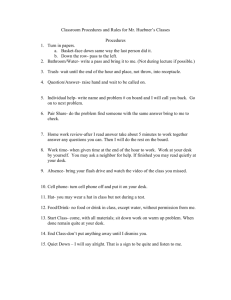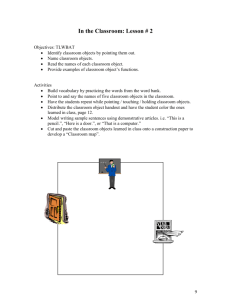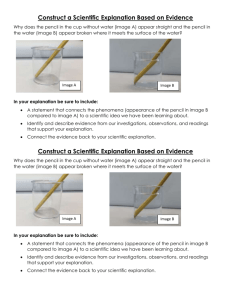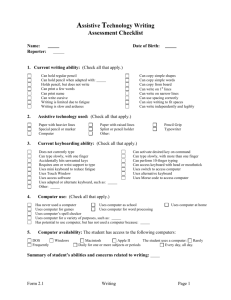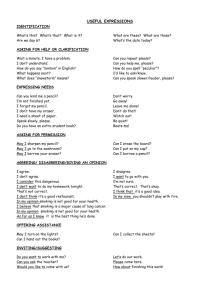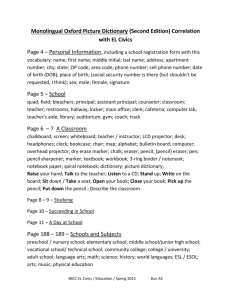Handwriting Intervention Strategies
advertisement
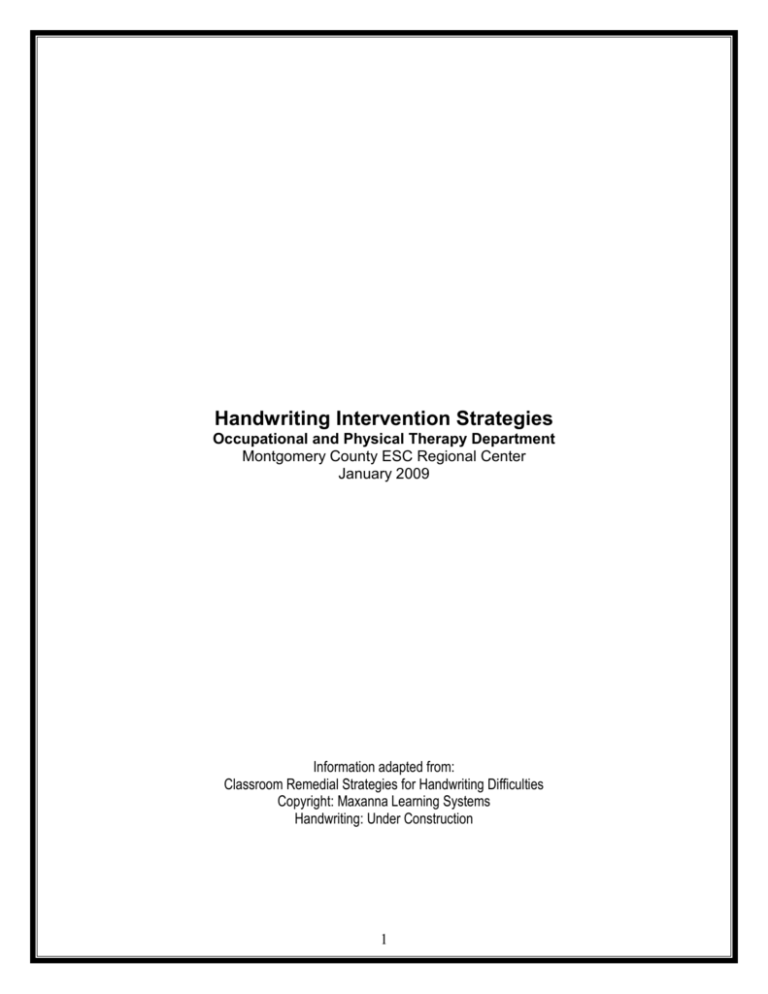
Handwriting Intervention Strategies Occupational and Physical Therapy Department Montgomery County ESC Regional Center January 2009 Information adapted from: Classroom Remedial Strategies for Handwriting Difficulties Copyright: Maxanna Learning Systems Handwriting: Under Construction 1 Problem: The student has difficulty with spatial organization when writing. Children who struggle with spatial ordering have decreased awareness regarding the spatial arrangement of letters, words or sentences on a page. In writing it looks like poor use of lines on paper, organizational problems, uneven spacing between letters, poor awareness of margins and many misspelled words. Recommendations: When students are copying from a worksheet or blackboard, insert markers that act as a signal to check spacing. A stop sign, red circle, or dash could be used (Include* spaces* between* your* words) or (When you see* the asterisk* pause to check* your spacing). Over-emphasize spaces between words (Make the spaces large enough so that they can’t go unnoticed). Have the student read the words out loud when writing and say the word “space” when there is a space. If the student has trouble staying within the lines of the paper, try different kinds of paper or modify current paper (a variety of paper can be found in many specialty catalogs such as Abilitations, Southpaw Enterprises, and Achievement Products at specialkidszone.com, etc.). Hi-Write paper: The entire area between the bottom and middle line on 3-lined paper is highlighted as a visual cue for placement of letters. Raised line paper Consider width of writing area: Some students will have greater success with intermediate versus primary paper based on development of hand skills. It is often easier to produce smaller movements when writing than larger movements. Consider highlighting lines or using single/double/triple lined paper. RediSpace paper: Provides green and red margins and a designated space for each letter. If the student has trouble starting on the left side of the paper, place a piece of green tape along the left side of the desk and a piece of red tape along the right side of the design to signal GO and STOP. Similarly, marker lines on the left and right side of each paper can be used. Use a physical spacer such as a Popsicle stick, finger, eraser, or small post-it note. Use large-square graph paper to help students visualize spacing of words and letters. Use graph paper or turn lined paper horizontally to create columns to help keep math problems aligned. Use a checklist for self-editing. Additional Recommendations: 2 Problem: The student writes too slowly to keep up with the class. When students are unable to keep up with the rest of the class, they may not have learned the letter patterns adequately. Speed should not be addressed until letter formations have been learned. Also consider other underlying areas of concern such as issues with attention, memory, language, graphomotor (movement associated with writing), and cognition. Recommendations: If letters have not been learned adequately, provide further instruction and daily practice. Mad Minutes: Have students write within a short timed period (one, two, or three minutes). Record the number of letters written legibly per minute. Try having the students copy or free write the lowercase or uppercase alphabet, words or sentences. Chart the results. Reduce the writing load. Have another student share his notes. Provide copies of important information. Provide keyboarding instructions or use an assistive device such as an Alphasmart. Consider cursive writing versus printing. Consider the writing instrument: mechanical pencil, pen, standard pencil, marker, crayon, etc. Other recommendations: Provide seat cushion for task attention. Use of a slant board to increase visual attention and improve hand positioning. Placement of desk/chair in the classroom as related to teacher or board. Provide a pencil grip. Increase the length of time given to complete assignments. Additional Recommendations: 3 Problem: The student has difficulty copying from the board. Recommendations: Rule out visual problems. Does the student have glasses or acuity issues? Is the student able to visual attend and track? Have students face the board when writing. Keep an open desk close to the blackboard for students who have difficulty copying from the board. Limit the amount of copying from the board. Make desktop copies of board work for students. Have the student re-write the information at near point or eliminate the need to copy. Keep the chalkboard uncluttered. Have the student use a slantboard to raise his visual field. Give extra time for the student to copy. Make sure information is written in a legible manner on the board with proper letter closure and size. Have the student use a color overlay, ruler or fingertip to help locate his/her place on the paper when changing vision to look from paper to board and vice versa. Additional Recommendations: 4 Problem: The student has a messy paper. Messy papers can be the result of several things. Often excessive pencil pressure is used which makes writing dark and difficult to erase. The paper may then rip when the student is writing or trying to correct errors. Over-working the letters can also contribute to a messy paper, as can inconsistent slant of letters. Messy papers are often seen with students who have attention issues. Lack of motivation to present neat work may play a factor. Recommendations: Provide a weighted pencil. Place a notebook under the writing paper for sensory feedback. Provide a slant board to raise the visual field and encourage proper hand positioning. Try a variety of writing instruments including mechanical pencils or pens, markers or crayons. Have the student cross out words instead of erasing. Try a pencil grip or triangular pencil aide to change pressure. Provide a model. Try a variety of writing paper which includes extra blank space between lines or have the student skip lines. Breakdown writing to focus on one aspect at a time. Engage in activities that provide deep pressure into the hands prior to writing. These tasks may include chair push-ups or working with putty. Trial different types of erasers including an art eraser. Teach proper erasing mechanics. Is the student stabilizing the paper with his non-dominant hand while erasing with his dominant hand? Use a checklist for self editing. Provide activities to focus on modifying pressure. Use a paintbrush with soft bristles and have the student paint thin lines. Additional Recommendations: 5 Problem: The student does not like to write. Recommendations: Help identify the areas of writing difficulty so that a remediation program can begin. For example, is it difficult to form the letters or come up with the information to be written down? Emphasize quality of handwriting and not quantity. Reduce the writing load. Comments on the student’s paper should emphasize the positive. Motivate the student through incentives, positive reinforcement, and genuine enthusiasm. Try using a handwriting contract. Compensatory Strategies: Reduce the writing load. Teach keyboarding skills as an alternative to writing. Allow oral reports and examinations. Allow the student to dictate or record assignment. Have another student share his or her class notes. Teacher to provide a copy or outline of class notes: The student can highlight or fill in details to follow the class discussion. Most importantly, stress one or two components of an assignment, but do not expect the student to meet all requirements. For example, on a report, organization and ideas may be the priority while spelling and punctuation are not emphasized. Additional Recommendations: 6 Problem: A student can only write the correct letter formation when a model is present. Recommendations: Emphasize a multisensory writing approach as noted below. Incorporate the “Phonics Dance” or other instructional method pairing letter names and sounds with movement and letter formations. Trace the letters in the air using large movements from the shoulder. Following the practice of letter formations, write letters or words with eyes closed. Play “Mystery Writing”: While the student holds a pencil as if to write, take the student’s hand and write a letter while his eyes are closed. Have the student guess what letter it is. Write in clay with a stylus. The resistance will increase sensory feedback. Have students work in pairs, dictating letters or words to each other to write. Have students correct each other’s errors. When having students trace letters, avoid dotted forms. Use a soft gray font or write the letters to be traced with a highlighter. This way the students are seeing the whole letter rather than a series of dots. Compensatory Strategies: Provide a desktop copy of the alphabet for easy reference. Modify the writing load until recall of letter formations is more automatic. Allow student to dictate or tape-record stories/responses. Allow student to give oral report or demonstrations rather than lengthy written reports. Let the student use a computer to type lengthy assignments until letter formations are more automatic. Additional Recommendations: 7 Problem: A student cannot maintain good sitting posture when writing. Recommendations: Poor posture when writing is often an indication of other underlying problems such as low muscle tone, visual deficits, limited attention, or poor body awareness. A good place to start to try and help a student is to ensure a proper fit for the chair and desk. The chair should allow the student to sit with his feet flat on the floor, with back supported against the backrest, and knees and hips flexed to 90 degrees. The desk should be at a height that allows for the arms to rest comfortably. Use a foot rest if desk chair is too tall and feet dangle (cover old phone books or boxes). Have the student sit toward the front of the chair, especially when writing. Back Support—a covered roll of paper towels attached to back of chair (use Velcro or duct tape) can help. Explore other seating options, like cushions, a different chair, a ball chair, etc. See OT or PT for ideas if needed. Begin writing activities with warm-ups to prepare and activate muscles needed to maintain posture and sitting balance. Stand up at desk. Put both hands on desk top and lean into hands. Rock back and forth and side to side for 20-30 seconds. Then have students put both palms together (like praying) in front of chest and push them together for 20-30 seconds. Chair pushups: Scoot away from the back of the chair. Put hands on seat beside hips/thighs. Lift bottom off the seat only using your arms, not pushing up with legs. Stand facing wall; place hands on wall at shoulder height and a little wider than shoulder width apart with fingers pointing up; body should be at approximately 45 degree angle. Bend elbows to touch nose to wall, and then straighten elbows to return to starting position. Watch that students are keeping heads straight and bodies straight. No sagging bellies!! Allow students to write in alternative positions like lying on the floor on their bellies. Writing on the blackboard or easel while standing helps improve shoulder stability, increase attention, minimize directional confusion, and improve wrist and hand position. Additional Recommendations: 8 Problem: The student writes with reversals. Reversals should diminish in second grade and be infrequent in third grade. Recommendations: Associate the problem letter with another letter that is not reversed (i.e. associate /b/ with /k/ or associate /d/ with /g/). Use cognitive cues to distinguish letters Lowercase /b/ is like uppercase /B/ without the top circle. A cue for remembering /d/ is /c/ comes first then add a line to make the /d/. The letter /E/ faces 3. Simplify letter formation and instructions. Start capital letters /B/, /D/, /E/, /F/, /K/, /L/, /P/, /R/ by placing the vertical line down first and then adding lines or curves to the right side. This can be done on a small chalkboard with the first vertical line going along the edge of the chalk board. Make a practice sheet with the common reversed letters among correct letter placement. Have the student find and correct the errors. Make up paired flash cards of common reversed letters and have the student match the pairs in games like Memory (can send home). Using a finger, write a letter on the student’s back. Have the student guess what letter it is. Follow this by having the student air write the letter. Finally have him write the letter on paper. Place a model of the letters typically reversed on the desk for easy reference. Provide a proofreading checklist at the desk as a reminder. Additional Recommendations: 9 Problem: The student writes with a hooked wrist. A hooked wrist is often seen with left-handed writers. While this position allows left-handed writers to see what they have written, it may slow down their writing speed. Correcting this position is more effective when done before second grade. Recommendations: Teach the student to position his/her paper correctly. For the left handed student, the paper is placed to the left of the body midline and tilted to the right 35-45 degrees. The left handed student should hold the pencil farther back then the right-handed student to allow for more visual clearance (2 cm for right and 3 cm for left). For the left handed student, place words to be copied on the right side of the paper for easy viewing by the student. Have the left or right handed student work on an inclined surface. This will automatically position the wrist and hand in a better position. This can be done by writing at the blackboard, easel, or slant board. Additional Recommendations: 10 Problem: The student does not hold a pencil correctly. Though some individual differences in pencil grasp are acceptable, a functional pencil grasp should be reinforced. Intervention to help develop a functional grasp is needed for students who: Complain of fatigue or pain when writing. Continue to use a primitive pencil grasp. Are unable to maintain a functional pencil grasp. Use a pencil grasp that does not allow adequate control. It is very difficult to change a pencil grasp once an ineffective grasp is firmly established, specifically after the 3rd grade. Early intervention is a must! Recommendations to encourage a more dynamic pencil grasp include: Use small pieces of crayon or chalk when coloring/writing on chalkboard. Retrain the student to use a tripod pencil grasp. Require the student to use the new grasp a few minutes each day. Gradually increase the time the new grasp is used over several weeks. As a class, have the students drop their pencils several times throughout the day. Emphasize picking the pencil up with the correct grasp. Practice cutting with scissors being sure to reinforce an appropriate scissor grasp: the scissors are held with the thumb and middle finger, while the index finger helps support and close the scissors. The ring and little finger should be inactive – as they are with writing. Use of theraputty (see your OT) or play dough. Compensatory Strategies: Use a pencil grip such as the Stetro or The Pencil Grip pencil aid to reinforce finger position and open up the web space. Use a triangular pencil aide for students who hold the pencil too lightly or squeeze too tightly. Mark the pencil with dots where the fingers should be placed. Use modified pencils such as a Twist and Write Pencil or a Ferby pencil. Additional Recommendations: 11 Problem: A student shows poor letter formation when writing. Recommendations: Look for similar letter formation sequences and group these letters together for instruction and practice. For example, “Magic C” letters (c,a,d,g,o,q) all start the same way, so teach and practice them together. If they have not yet been learned, use activities to teach directional and positional terms needed for handwriting (i.e. right, left, top, bottom, middle). Teach problem letters stroke by stroke, giving verbal directions that match the movement. Monitor daily writing practice to ensure that the proper letter formations are reinforced. It is very difficult to break habits once they are formed. One-on-one or small group instruction work best for this. Have the student repeat verbal directions out loud as she writes the letter. Always demonstrate how to write a letter so the students can see the correct direction and sequence of the letter strokes. Have students write on a chalkboard or other vertical surface to reinforce directionality and prevent confusion. On a vertical surface, up means up and down means down. On a horizontal surface, up means away from oneself and down means toward oneself. Compensatory Strategies: Analyze problem letters and make necessary modifications to the letter. Eliminating features such as monkey tails and loops (for cursive) may help with letter formation. Have a student use a computer to complete his writing assignments. Have a student dictate his assignments. Pair students with study buddies who assist with written assignments. Additional Recommendations: 12
